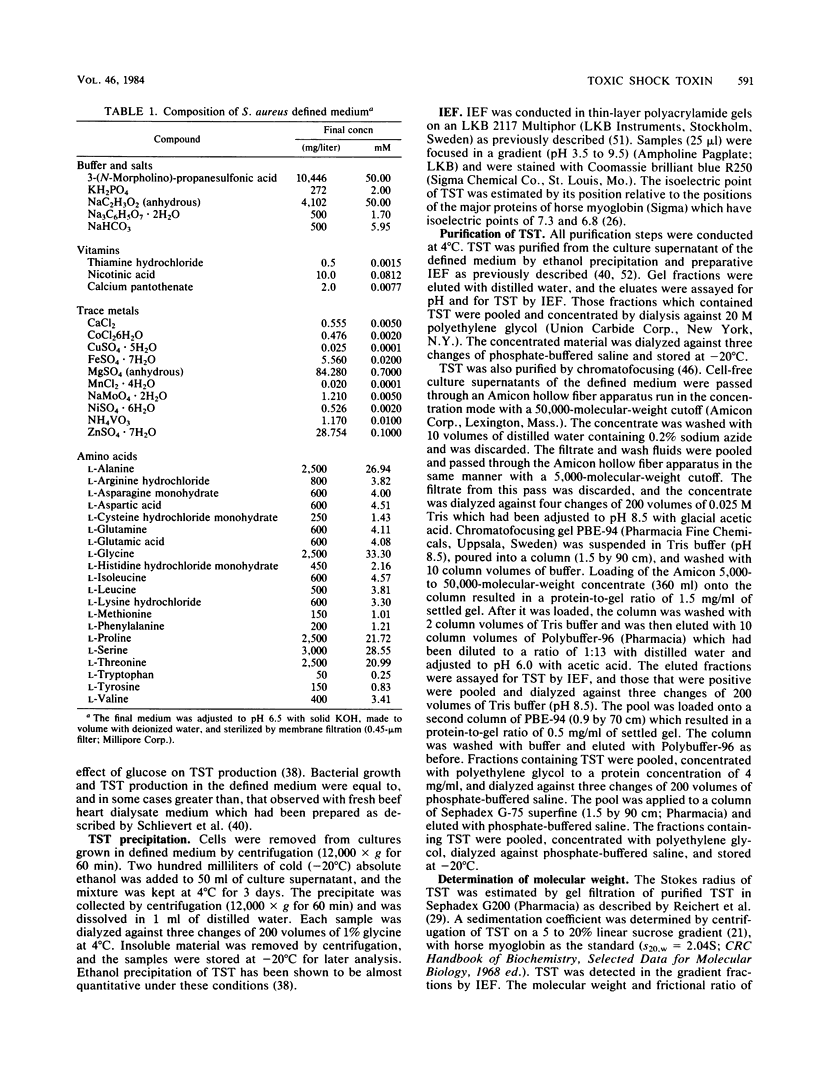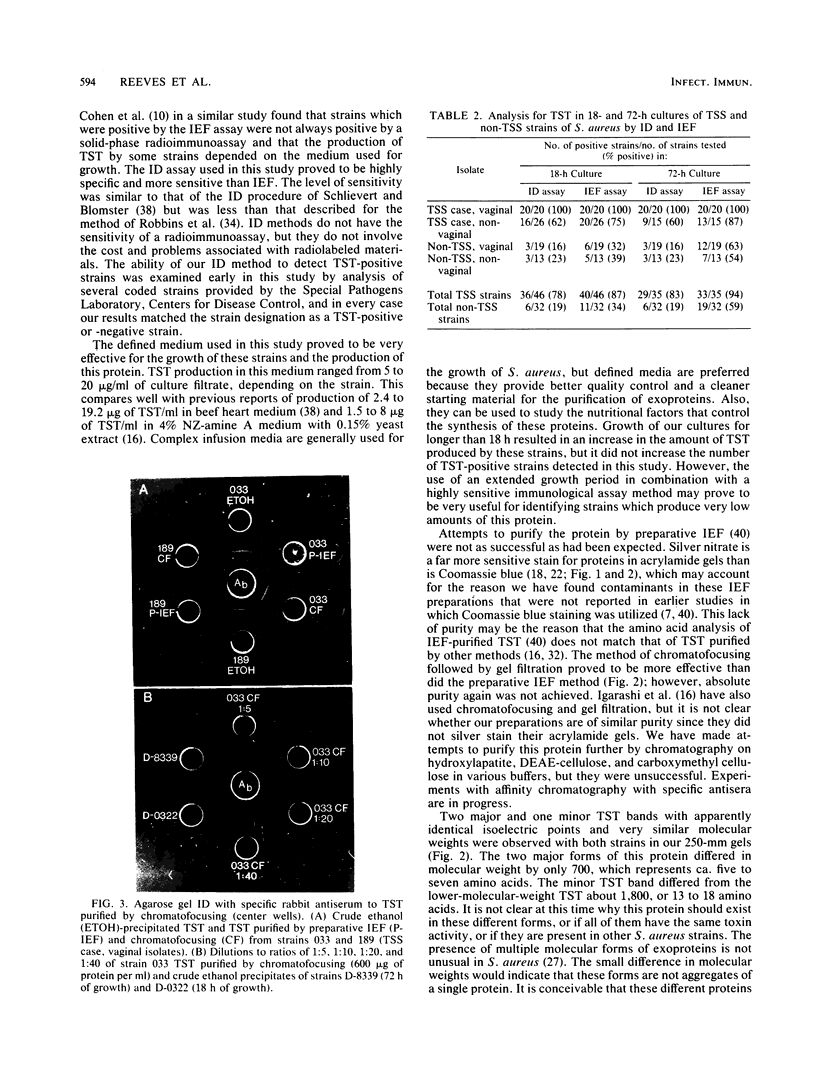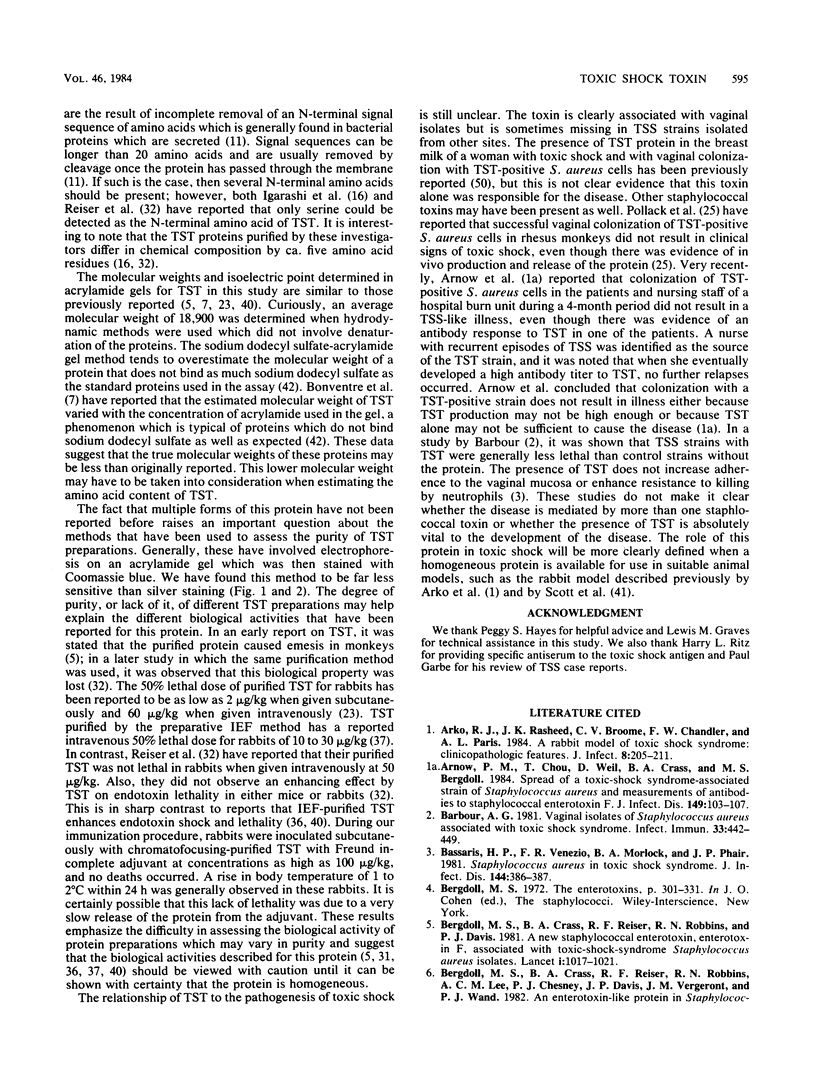Abstract
Toxic shock toxin (TST), also known as pyrogenic exotoxin C (Schlievert et al., J. Infect. Dis. 143:509-516, 1981) and staphylococcal enterotoxin F (Bergdoll et al., Lancet i:1017-1021, 1981), was purified from toxic shock strains of Staphylococcus aureus by preparative isoelectric focusing and by chromatofocusing. Neither method produced an absolutely pure protein as determined by silver staining of sodium dodecyl sulfate-acrylamide gels, although chromatofocusing was the better method of the two. Three molecular weight variants of the protein were found in the two toxic shock syndrome strains that were studied, regardless of the purification method that was used. An isoelectric point of 7.15 and molecular weights of 21,400, 22,100, and 23,200 were determined for the different forms of the protein from electrophoresis data. A sedimentation coefficient of 2.3S was determined by sucrose gradient centrifugation, and a Stokes radius of 2 X 10(-7) cm was determined by gel filtration. An average molecular weight of 18,900 for all of the TST forms was calculated from these data by the Stokes-Einstein equation. A survey for TST in 32 control and 46 toxic shock strains of S. aureus by isoelectric focusing and by agarose gel double immunodiffusion with specific rabbit antiserum revealed that the isoelectric focusing method tends to overestimate the number of TST-positive strains because of the detection of non-TST, neutral staphylococcal proteins. Based on immunodiffusion data, the association of TST with toxic shock strains was found to be 100% in vaginal isolates and 62% in non-vaginal isolates. In the control strains, TST was found in 16% of the vaginal strains and 23% of the non-vaginal strains. The value of this toxin as a marker for toxic shock and its relationship to the pathogenesis of this disease are discussed.
Full text
PDF







Images in this article
Selected References
These references are in PubMed. This may not be the complete list of references from this article.
- Arko R. J., Rasheed J. K., Broome C. V., Chandler F. W., Paris A. L. A rabbit model of toxic shock syndrome: clinicopathological features. J Infect. 1984 May;8(3):205–211. doi: 10.1016/s0163-4453(84)93859-3. [DOI] [PubMed] [Google Scholar]
- Arnow P. M., Chou T., Weil D., Crass B. A., Bergdoll M. S. Spread of a toxic-shock syndrome-associated strain of Staphylococcus aureus and measurement of antibodies to staphylococcal enterotoxin F. J Infect Dis. 1984 Jan;149(1):103–107. doi: 10.1093/infdis/149.1.103. [DOI] [PubMed] [Google Scholar]
- Barbour A. G. Vaginal isolates of Staphylococcus aureus associated with toxic shock syndrome. Infect Immun. 1981 Aug;33(2):442–449. doi: 10.1128/iai.33.2.442-449.1981. [DOI] [PMC free article] [PubMed] [Google Scholar]
- Bassaris H. P., Venezio F. R., Morlock B. A., Phair J. P. Staphylococcus aureus in toxic-shock syndrome. J Infect Dis. 1981 Oct;144(4):386–387. doi: 10.1093/infdis/144.4.386. [DOI] [PubMed] [Google Scholar]
- Bergdoll M. S., Crass B. A., Reiser R. F., Robbins R. N., Davis J. P. A new staphylococcal enterotoxin, enterotoxin F, associated with toxic-shock-syndrome Staphylococcus aureus isolates. Lancet. 1981 May 9;1(8228):1017–1021. doi: 10.1016/s0140-6736(81)92186-3. [DOI] [PubMed] [Google Scholar]
- Bonventre P. F., Weckbach L., Staneck J., Schlievert P. M., Thompson M. Production of staphylococcal enterotoxin F and pyrogenic exotoxin C by Staphylococcus aureus isolates from toxic shock syndrome-associated sources. Infect Immun. 1983 Jun;40(3):1023–1029. doi: 10.1128/iai.40.3.1023-1029.1983. [DOI] [PMC free article] [PubMed] [Google Scholar]
- Bradford M. M. A rapid and sensitive method for the quantitation of microgram quantities of protein utilizing the principle of protein-dye binding. Anal Biochem. 1976 May 7;72:248–254. doi: 10.1006/abio.1976.9999. [DOI] [PubMed] [Google Scholar]
- Cohen M. L., Graves L. M., Hayes P. S., Gibson R. J., Rasheed J. K., Feeley J. C. Toxic shock syndrome: modification and comparison of methods for detecting marker proteins in Staphylococcus aureus. J Clin Microbiol. 1983 Aug;18(2):372–375. doi: 10.1128/jcm.18.2.372-375.1983. [DOI] [PMC free article] [PubMed] [Google Scholar]
- Davis B. D., Tai P. C. The mechanism of protein secretion across membranes. Nature. 1980 Jan 31;283(5746):433–438. doi: 10.1038/283433a0. [DOI] [PubMed] [Google Scholar]
- Davis J. P., Chesney P. J., Wand P. J., LaVenture M. Toxic-shock syndrome: epidemiologic features, recurrence, risk factors, and prevention. N Engl J Med. 1980 Dec 18;303(25):1429–1435. doi: 10.1056/NEJM198012183032501. [DOI] [PubMed] [Google Scholar]
- Hutner S. H. Inorganic nutrition. Annu Rev Microbiol. 1972;26:313–346. doi: 10.1146/annurev.mi.26.100172.001525. [DOI] [PubMed] [Google Scholar]
- Igarashi H., Fujikawa H., Usami H., Kawabata S., Morita T. Purification and characterization of Staphylococcus aureus FRI 1169 and 587 toxic shock syndrome exotoxins. Infect Immun. 1984 Apr;44(1):175–181. doi: 10.1128/iai.44.1.175-181.1984. [DOI] [PMC free article] [PubMed] [Google Scholar]
- Kapral F. A. Epidermal toxin production by Staphylococcus aureus strains from patients with toxic shock syndrome. Ann Intern Med. 1982 Jun;96(6 Pt 2):972–974. doi: 10.7326/0003-4819-96-6-972. [DOI] [PubMed] [Google Scholar]
- Lema M., Brown A. Electrophoretic characterization of soluble protein extracts of Legionella pneumophila and other members of the family Legionellaceae. J Clin Microbiol. 1983 Jun;17(6):1132–1140. doi: 10.1128/jcm.17.6.1132-1140.1983. [DOI] [PMC free article] [PubMed] [Google Scholar]
- Lentino J. R., Rytel M. W., Davis J. P. Serologic evidence of noninvasive nature of Staphylococcus aureus infection in the toxic-shock syndrome. N Engl J Med. 1981 Sep 10;305(11):641–642. doi: 10.1056/NEJM198109103051112. [DOI] [PubMed] [Google Scholar]
- Linnemann C. C., Jr, Staneck J. L., Hornstein S., Barden T. P., Rauh J. L., Bonventre P. F., Buncher C. R., Beiting A. The epidemiology of genital colonization with Staphylococcus aureus. Ann Intern Med. 1982 Jun;96(6 Pt 2):940–944. doi: 10.7326/0003-4819-96-6-940. [DOI] [PubMed] [Google Scholar]
- MARTIN R. G., AMES B. N. A method for determining the sedimentation behavior of enzymes: application to protein mixtures. J Biol Chem. 1961 May;236:1372–1379. [PubMed] [Google Scholar]
- Morrissey J. H. Silver stain for proteins in polyacrylamide gels: a modified procedure with enhanced uniform sensitivity. Anal Biochem. 1981 Nov 1;117(2):307–310. doi: 10.1016/0003-2697(81)90783-1. [DOI] [PubMed] [Google Scholar]
- Notermans S., Dufrenne J. B. A simple purification method for enterotoxin F produced by Staphylococcus aureus and some properties of the toxin. Antonie Van Leeuwenhoek. 1982 Dec;48(5):447–455. doi: 10.1007/BF00448416. [DOI] [PubMed] [Google Scholar]
- OUCHTERLONY O. Antigen-antibody reactions in gels. IV. Types of reactions in coordinated systems of diffusion. Acta Pathol Microbiol Scand. 1953;32(2):230–240. [PubMed] [Google Scholar]
- Pollack M., Weinberg W. G., Hoskins W. J., O'Brien W. F., Iannini P. B., Anderson S. E., Schlievert P. M. Toxinogenic vaginal infections due to Staphylococcus aureus in menstruating rhesus monkeys without toxic-shock syndrome. J Infect Dis. 1983 May;147(5):963–964. doi: 10.1093/infdis/147.5.963. [DOI] [PubMed] [Google Scholar]
- Radola B. J. Isoelectric focusing in layers of granulated gels. I. Thin-layer isoelectric focusing of proteins. Biochim Biophys Acta. 1973 Feb 21;295(2):412–428. doi: 10.1016/0005-2795(73)90037-8. [DOI] [PubMed] [Google Scholar]
- Reeves M. W., Drummond M. C., Tager M. Partial purification and characterization of the multiple molecular forms of staphylococcal clotting activity (coagulase). J Bacteriol. 1981 Dec;148(3):861–868. doi: 10.1128/jb.148.3.861-868.1981. [DOI] [PMC free article] [PubMed] [Google Scholar]
- Reeves M. W., Pine L., Hutner S. H., George J. R., Harrell W. K. Metal requirements of Legionella pneumophila. J Clin Microbiol. 1981 Apr;13(4):688–695. doi: 10.1128/jcm.13.4.688-695.1981. [DOI] [PMC free article] [PubMed] [Google Scholar]
- Reichert L. E., Jr, Rasco M. A., Ward D. N., Niswender G. D., Midgley A. R., Jr Isolation and properties of subunits of bovine pituitary luteinizing hormone. J Biol Chem. 1969 Oct 10;244(19):5110–5117. [PubMed] [Google Scholar]
- Reingold A. L., Hargrett N. T., Shands K. N., Dan B. B., Schmid G. P., Strickland B. Y., Broome C. V. Toxic shock syndrome surveillance in the United States, 1980 to 1981. Ann Intern Med. 1982 Jun;96(6 Pt 2):875–880. doi: 10.7326/0003-4819-96-6-875. [DOI] [PubMed] [Google Scholar]
- Reingold A. L. Nonmenstrual toxic shock syndrome: the growing picture. JAMA. 1983 Feb 18;249(7):932–932. [PubMed] [Google Scholar]
- Reiser R. F., Robbins R. N., Khoe G. P., Bergdoll M. S. Purification and some physicochemical properties of toxic-shock toxin. Biochemistry. 1983 Aug 2;22(16):3907–3912. doi: 10.1021/bi00285a028. [DOI] [PubMed] [Google Scholar]
- Ritz H. L., Kirkland J. J., Bond G. G., Warner E. K., Petty G. P. Association of high levels of serum antibody to staphylococcal toxic shock antigen with nasal carriage of toxic shock antigen-producing strains of Staphylococcus aureus. Infect Immun. 1984 Mar;43(3):954–958. doi: 10.1128/iai.43.3.954-958.1984. [DOI] [PMC free article] [PubMed] [Google Scholar]
- Robbins R., Gould S., Bergdoll M. Detecting the enterotoxigenicity of Staphylococcus aureus strains. Appl Microbiol. 1974 Dec;28(6):946–950. doi: 10.1128/am.28.6.946-950.1974. [DOI] [PMC free article] [PubMed] [Google Scholar]
- Rogolsky M. Nonenteric toxins of Staphylococcus aureus. Microbiol Rev. 1979 Sep;43(3):320–360. doi: 10.1128/mr.43.3.320-360.1979. [DOI] [PMC free article] [PubMed] [Google Scholar]
- Schlievert P. M. Alteration of immune function by staphylococcal pyrogenic exotoxin type C: possible role in toxic-shock syndrome. J Infect Dis. 1983 Mar;147(3):391–398. doi: 10.1093/infdis/147.3.391. [DOI] [PubMed] [Google Scholar]
- Schlievert P. M., Blomster D. A. Production of staphylococcal pyrogenic exotoxin type C: influence of physical and chemical factors. J Infect Dis. 1983 Feb;147(2):236–242. doi: 10.1093/infdis/147.2.236. [DOI] [PubMed] [Google Scholar]
- Schlievert P. M. Enhancement of host susceptibility to lethal endotoxin shock by staphylococcal pyrogenic exotoxin type C. Infect Immun. 1982 Apr;36(1):123–128. doi: 10.1128/iai.36.1.123-128.1982. [DOI] [PMC free article] [PubMed] [Google Scholar]
- Schlievert P. M., Osterholm M. T., Kelly J. A., Nishimura R. D. Toxin and enzyme characterization of Staphylococcus aureus isolates from patients with and without toxic shock syndrome. Ann Intern Med. 1982 Jun;96(6 Pt 2):937–940. doi: 10.7326/0003-4819-96-6-937. [DOI] [PubMed] [Google Scholar]
- Schlievert P. M., Shands K. N., Dan B. B., Schmid G. P., Nishimura R. D. Identification and characterization of an exotoxin from Staphylococcus aureus associated with toxic-shock syndrome. J Infect Dis. 1981 Apr;143(4):509–516. doi: 10.1093/infdis/143.4.509. [DOI] [PubMed] [Google Scholar]
- Scott D. F., Kling J. M., Kirkland J. J., Best G. K. Characterization of Staphylococcus aureus isolates from patients with toxic shock syndrome, using polyethylene infection chambers in rabbits. Infect Immun. 1983 Jan;39(1):383–387. doi: 10.1128/iai.39.1.383-387.1983. [DOI] [PMC free article] [PubMed] [Google Scholar]
- Shands K. N., Schmid G. P., Dan B. B., Blum D., Guidotti R. J., Hargrett N. T., Anderson R. L., Hill D. L., Broome C. V., Band J. D. Toxic-shock syndrome in menstruating women: association with tampon use and Staphylococcus aureus and clinical features in 52 cases. N Engl J Med. 1980 Dec 18;303(25):1436–1442. doi: 10.1056/NEJM198012183032502. [DOI] [PubMed] [Google Scholar]
- Shapiro A. L., Viñuela E., Maizel J. V., Jr Molecular weight estimation of polypeptide chains by electrophoresis in SDS-polyacrylamide gels. Biochem Biophys Res Commun. 1967 Sep 7;28(5):815–820. doi: 10.1016/0006-291x(67)90391-9. [DOI] [PubMed] [Google Scholar]
- Siegel L. M., Monty K. J. Determination of molecular weights and frictional ratios of proteins in impure systems by use of gel filtration and density gradient centrifugation. Application to crude preparations of sulfite and hydroxylamine reductases. Biochim Biophys Acta. 1966 Feb 7;112(2):346–362. doi: 10.1016/0926-6585(66)90333-5. [DOI] [PubMed] [Google Scholar]
- Todd J., Fishaut M., Kapral F., Welch T. Toxic-shock syndrome associated with phage-group-I Staphylococci. Lancet. 1978 Nov 25;2(8100):1116–1118. doi: 10.1016/s0140-6736(78)92274-2. [DOI] [PubMed] [Google Scholar]
- Tsang V. C., Hancock K., Maddison S. E., Beatty A. L., Moss D. M. Demonstration of species-specific and cross-reactive components of the adult microsomal antigens from Schistosoma mansoni and S. japonicum (MAMA and JAMA). J Immunol. 1984 May;132(5):2607–2613. [PubMed] [Google Scholar]
- Tsang V. C., Peralta J. M., Simons A. R. Enzyme-linked immunoelectrotransfer blot techniques (EITB) for studying the specificities of antigens and antibodies separated by gel electrophoresis. Methods Enzymol. 1983;92:377–391. doi: 10.1016/0076-6879(83)92032-3. [DOI] [PubMed] [Google Scholar]
- Vergeront J. M., Evenson M. L., Crass B. A., Davis J. P., Bergdoll M. S., Wand P. J., Noble J. H., Petersen G. K. Recovery of staphylococcal enterotoxin F from the breast milk of a woman with toxic-shock syndrome. J Infect Dis. 1982 Oct;146(4):456–459. doi: 10.1093/infdis/146.4.456. [DOI] [PubMed] [Google Scholar]
- Wu C. H., Bergdoll M. S. Stimulation of Enterotoxin B Production II. Synthetic Medium for Staphylococcal Growth and Enterotoxin B Production. Infect Immun. 1971 Jun;3(6):784–792. doi: 10.1128/iai.3.6.784-792.1971. [DOI] [PMC free article] [PubMed] [Google Scholar]
- de Nooij M. P., van Leeuwen W. J., Notermans S. Enterotoxin production by strains of Staphylococcus aureus isolated from clinical and non-clinical specimens with special reference to enterotoxin F and toxic shock syndrome. J Hyg (Lond) 1982 Dec;89(3):499–505. doi: 10.1017/s0022172400071060. [DOI] [PMC free article] [PubMed] [Google Scholar]
- de Saxe M. J., Wieneke A. A., de Azevedo J., Arbuthnott J. P. Staphylococci associated with toxic shock syndrome in the United Kingdom. Ann Intern Med. 1982 Jun;96(6 Pt 2):991–996. doi: 10.7326/0003-4819-96-6-991. [DOI] [PubMed] [Google Scholar]





